Fuzzy Prediction of Power Lithium Ion Battery State of Function Based on the Fuzzy c-Means Clustering Algorithm
Abstract
:1. Introduction
2. Selection of Relevant Variables of SOF
2.1. SOC
2.2. SOH
2.3. Maximum C-Rate (Charge–Discharge Rate)
3. Prediction of SOF Based on the Fuzzy Inference System Optimized by the FCM Algorithm
3.1. Fuzzy c-Means Clustering
3.2. Estimate the SOF
(L,L,L,L), (L,L,M,L), (L,L,H,L), (L,M,L,L), (L,M,M,M), (M,L,L,M), (M,L,M,M), (M,M,H,H), (L,M,H,M), (L,H,L,L), (L,H,M,M), (L,H,H,M), (M,L,L,M), (M,L,M,M), (M,L,H,M), (M,M,L,M), (M,M,M,M), (M,M,H,H), (M,H,L,M), (M,H,M,M), (M,H,H,H), (H,L,L,M), (H,L,M,M), (H,L,H,M), (H,M,L,M), (H,M,M,M), (H,M,H,H), (H,H,L,M), (H,H,M,H), (H,H,H,H).
4. SOF Measurement
- (1)
- Leave the battery for two hours to make sure that it stays in a stable state;
- (2)
- Adjust the instrument to ensure that correct readings of the current voltage and the current of the battery are obtained;
- (3)
- Set the discharge working mode as the cyclic test mode. The parameters of the starting current, termination current, termination voltage, step interval and time-step interval are set, respectively. Then, start the measurement.
- (4)
- Measure the maximum discharge current while the voltage drops to the termination voltage. At this time, the product of the voltage and current is taken as the current SOF of the battery.
5. Conclusions
Author Contributions
Funding
Conflicts of Interest
References
- Farmann, A.; Sauer, D.U. A comprehensive review of on-board State-of-Available-Power prediction techniques for lithium-ion batteries in electric vehicles. J. Power Sources 2016, 329, 123–137. [Google Scholar] [CrossRef]
- Masoudi, R.; Uchida, T.; Mcphee, J. Parameter estimation of an electrochemistry-based lithium-ion battery model. J. Power Sources 2015, 291, 215–224. [Google Scholar] [CrossRef] [Green Version]
- Zhang, C.P.; Zhang, C.N.; Sharkh, S.M. Estimation of Real-Time Peak Power Capability of a Traction Battery Pack Used in an HEV. In Proceedings of the 2010 Asia-Pacific Power & Energy Engineering Conference, Chengdu, China, 28–31 March 2010; pp. 1–6. [Google Scholar]
- Juang, L.W.; Kollmeyer, P.J.; Jahns, T.M.; Lorenz, R.D. Implementation of online battery state-of-power and state-of-function estimation in electric vehicle applications. Energy Conver. Congr. Expos. 2012, 11, 1819–1826. [Google Scholar]
- Wang, L.; Cheng, Y.; Zou, J. Battery available power prediction of hybrid electric vehicle based on improved Dynamic Matrix Control algorithms. J. Power Sources 2014, 261, 337–347. [Google Scholar] [CrossRef]
- Xiong, R.; He, H.; Sun, F.; Liu, X.; Liu, Z. Model-based state of charge and peak power capability joint estimation of lithium-ion battery in plug-in hybrid electric vehicles. J. Power Sources 2013, 229, 159–169. [Google Scholar] [CrossRef]
- Klir, G.J.; Yuan, B. Fuzzy Sets and Fuzzy Logic—Theory and Applications; Prentice-Hall, Inc.: Upper Saddle River, NJ, USA, 1994; pp. 283–287. [Google Scholar]
- Malkhandi, S. Fuzzy logic-based learning system and estimation of state-of-charge of lead-acid battery. Eng. Appl. Artif. Intell. 2006, 19, 479–485. [Google Scholar] [CrossRef]
- Li, S.G.; Sharkh, S.M.; Walsh, F.C.; Zhang, C.N. Energy and Battery Management of a Plug-In Series Hybrid Electric Vehicle Using Fuzzy Logic. IEEE Trans. Veh. Technol. 2011, 60, 3571–3585. [Google Scholar] [CrossRef]
- Gan, L.; Yang, F.; Shi, Y.F.; He, H.L. Lithium-ion battery state of function estimation based on fuzzy logic algorithm with associated variables. In Proceedings of the IOP Conference Series: Earth and Environmental Science, Prague, Czech Republic, 11–15 September 2017. [Google Scholar]
- Bezdek, J.C.; Ehrlich, R.; Full, W. FCM: The fuzzy c-means clustering algorithm. Comput. Geosci. 1984, 10, 191–203. [Google Scholar] [CrossRef]
- Dagher, I. Fuzzy clustering with optimized-parameters multiple Gaussian Kernels. In Proceedings of the IEEE International Conference on Fuzzy Systems, Istanbul, Turkey, 2–5 August 2015; pp. 1–6. [Google Scholar]
- Waag, W.; Sauer, D.U. Secondary Batteries–Lead–Acid Systems State-of-Charge/Health; Elsevier B.V: Amsterdam, The Netherlands, 2009; Volume 796. [Google Scholar]
- García, S.; Luengo, J.; Herrera, F. Data Preprocessing in Data Mining; Springer: Berlin/Heidelberg, Germany, 2015. [Google Scholar]
- Van Bree Patrick, J.; Veltman, A.; Hendrix, W.H.A.; van den Bosch, P.P.J. Prediction of Battery Behavior Subject to High-Rate Partial State of Charge. IEEE Trans. Veh. Technol. 2009, 58, 1–2. [Google Scholar] [CrossRef]
- Scrosati, B.; Garche, J. Lithium batteries: Status, prospects and future. J. Power Sources 2010, 195, 2419–2430. [Google Scholar] [CrossRef]
- Goriparti, S.; Miele, E.; Angelis, F.D.; Fabrizio, E.D.; Zaccaria, R.P.; Capiglia, C. Review on recent progress of nanostructured anode materials for Li-ion batteries. J. Power Sources 2014, 257, 421–443. [Google Scholar] [CrossRef] [Green Version]
- Zou, Y.; Hu, X.; Ma, H.; Li, S.E. Combined state of charge and state of health estimation over lithium-ion battery cell cycle lifespan for electric vehicles. J. Power Sources 2015, 273, 793–803. [Google Scholar] [CrossRef]
- Wang, S.; Verbrugge, M.; Wang, J.S.; Liu, P. Power prediction from a battery state estimator that incorporates diffusion resistance. J. Power Sources 2012, 214, 399–406. [Google Scholar] [CrossRef]
- Hu, Y.; Yurkovich, S.; Guezennec, Y.; Yurkovich, B.J. A technique for dynamic battery model identification in automotive applications using linear parameter varying structures. Control Eng. Pract. 2009, 15, 1190–1201. [Google Scholar] [CrossRef]
- Malysz, P.; Ye, J.; Gu, R.; Yang, H.; Emadi, A. Battery state-of-power peak current calculation and verification using an asymmetric parameter equivalent circuit model. IEEE Trans. Veh. Technol. 2015, 65, 4512–4522. [Google Scholar] [CrossRef]
- Hu, X.; Xiong, R.; Egardt, B. Model-based dynamic power assessment of lithium-ion batteries considering different operating conditions. Ind. Inf. IEEE Trans. 2014, 10, 1948–1959. [Google Scholar] [CrossRef]
- Ceraolo, M. New dynamical models of lead-acid batteries. Power Syst. IEEE Trans. 2000, 15, 1184–1190. [Google Scholar] [CrossRef]
- Zhang, H.; Chow, M.-Y. Comprehensive dynamic battery modeling for PHEV applications. In Proceedings of the Power and Energy Society General Meeting, Providence, RI, USA, 25–29 July 2010; pp. 1–6. [Google Scholar]
- Buller, S. Impedance-based Simulation Models for Energy Storage Devices in Advanced Automotive Power Systems. Ph.D. Thesis, Institute for Power Electronics and Electrical Drives, RWTH Aachen University, Aachen, Germany, 2003. [Google Scholar]
- Hu, X.; Li, S.; Peng, H. A comparative study of equivalent circuit models for liion batteries. J. Power Sources 2012, 198, 359–367. [Google Scholar] [CrossRef]
- Li, X.; Sun, J.; Hu, Z.; Lu, R.; Zhu, C.; Wu, G. A New Method of State of Peak Power Capability Prediction for Li-Ion Battery. In Proceedings of the 2015 IEEE Vehicle Power and Propulsion Conference (VPPC), Montreal, QC, Canada, 19–22 October 2015. [Google Scholar]
- Fleischer, C.; Waag, W.; Sauer, D.U. Adaptive on-line State-of-Available-Power prediction of lithium-ion batteries. J. Power Electron. 2013, 13, 516–527. [Google Scholar] [CrossRef]
- Xiong, R.; He, H.; Sun, F.; Zhao, K. Online estimation of peak power capability of Li-ion batteries in electric vehicles by a hardware-in-loop approach. Energies 2012, 5, 1455–1469. [Google Scholar] [CrossRef]
- Root, M. The Tab Battery Book e an In-depth Guide to Construction, Design, and Use; The McGraw-Hill Companies: New York, NY, USA, 2011; ISBN 978-0-07-173991-7. [Google Scholar]
- Mueller, S.C.; Sandner, P.G.; Welpe, I.M. Monitoring innovation in electrochemical energy storage technologies: A patent-based approach. Appl. Energy 2015, 137, 537–544. [Google Scholar] [CrossRef] [Green Version]
- Zadeh, L.A. Fuzzy sets. Inf. Control 1965, 8, 338–353. [Google Scholar] [CrossRef] [Green Version]
- Zadeh, L.A. Fuzzy logic. Computer 1988, 21, 83–93. [Google Scholar] [CrossRef]
- Lee, C.C. Fuzzy logic in control systems: Fuzzy logic controller—Parts I and II. IEEE Trans. Syst. Man Cybern. 1990, 20, 404–435. [Google Scholar] [CrossRef]
- Chang, L.C.; Chu, H.J.; Chen, Y.W. A fuzzy inference system for the conjunctive use of surface and subsurface water. Adv. Fuzzy Syst. 2013, 2013. [Google Scholar] [CrossRef]
- Firat, M.; Turan, M.E.; Yurdusev, M.A. Comparative analysis of fuzzy inference systems for water consumption time series prediction. J. Hydrol. 2009, 374, 235–241. [Google Scholar] [CrossRef]
- Lohani, A.K.; Goel, N.K.; Bhatia, K.K.S. Improving real time flood forecasting using fuzzy inference system. J. Hydrol. 2014, 509, 25–41. [Google Scholar] [CrossRef]
- Pinzon-Morales, R.-D.; Baquero-Duarte, K.-A.; Orozco-Gutierrez, A.-A.; Grisales-Palacio, V.-H. Pattern Recognition of Surface EMG Biological Signals by Means of Hilbert Spectrum and Fuzzy Clustering; Arabnia, H.R., Tran, Q.-N., Eds.; Springer: New York, NY, USA, 2011; pp. 201–209. [Google Scholar]
- Bezdek, J.C. Pattern Recognition with Fuzzy Objective Function Algorithms; Plenum Press: New York, NY, USA, 1981. [Google Scholar]
- Ahmed, M.N.; Yamany, S.M.; Mohamed, N.; Farag, A.A.; Moriarty, T. A modified fuzzy C-means algorithm for bias field estimation and segmentation of MRI data. IEEE Trans. Med. Imaging 2002, 21, 193–199. [Google Scholar] [CrossRef]
- Maulik, U.; Bandyopadhyay, S. Fuzzy partitioning using a real coded variable length genetic algorithm for pixel classification. IEEE Trans. Geosci. Remote Sens. 2003, 41, 1075–1081. [Google Scholar] [CrossRef]
- Celikyilmaz, A.; Trksen, I.B. Modeling Uncertainty with Fuzzy Logic: With Recent Theory and Applications, 1st ed.; Springer: Berlin, Germany, 2009. [Google Scholar]
- Dovžan, D.; Škrjanc, I. Recursive fuzzy c-means clustering for recursive fuzzy identification of time-varying processes. ISA Trans. 2011, 50, 159–169. [Google Scholar] [CrossRef]
- Mendes, J.; Araújo, R.; Souza, F. Adaptive fuzzy identification and predictive control for industrial processes. Expert Syst. Appl. 2013, 40, 6964–6975. [Google Scholar] [CrossRef]

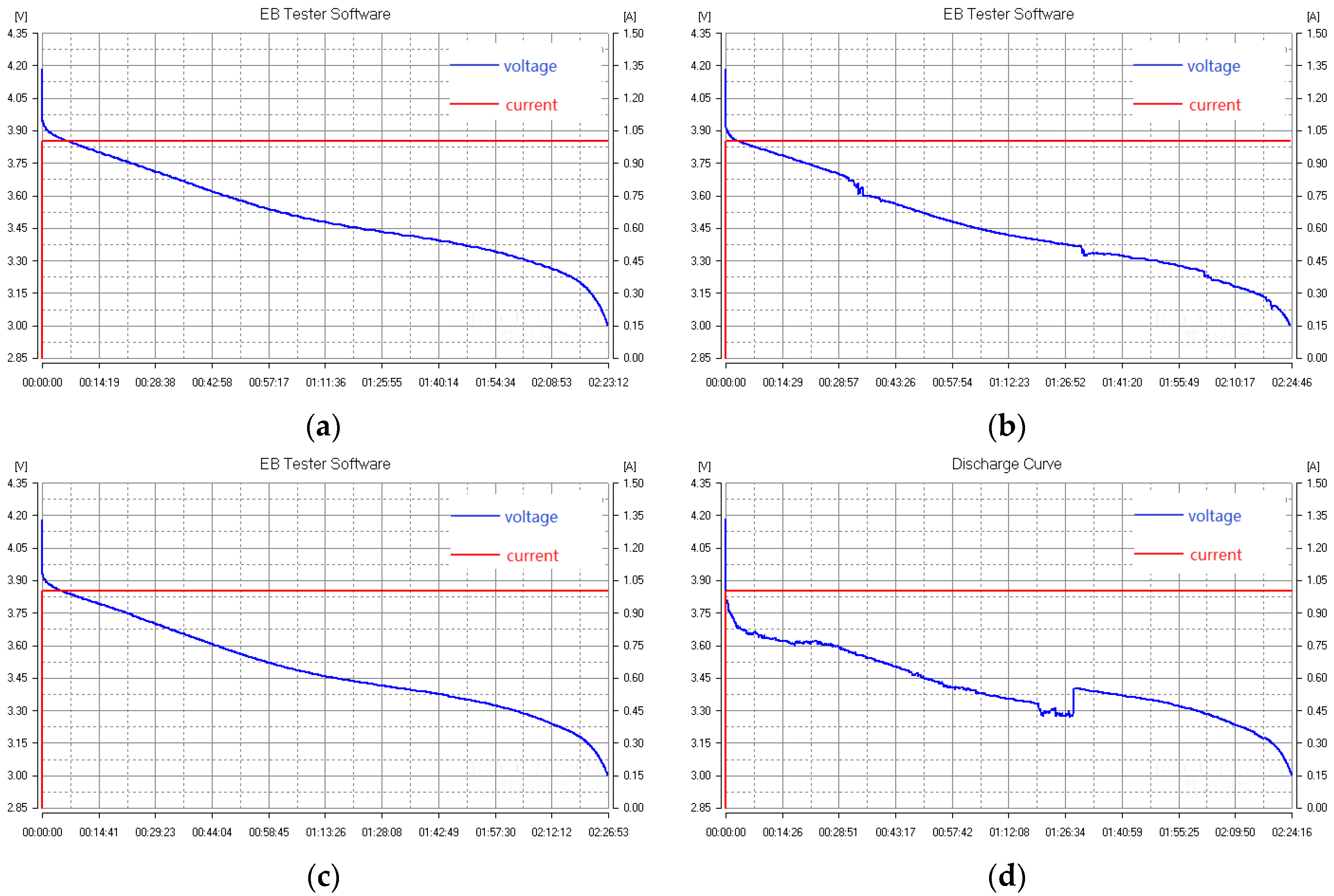

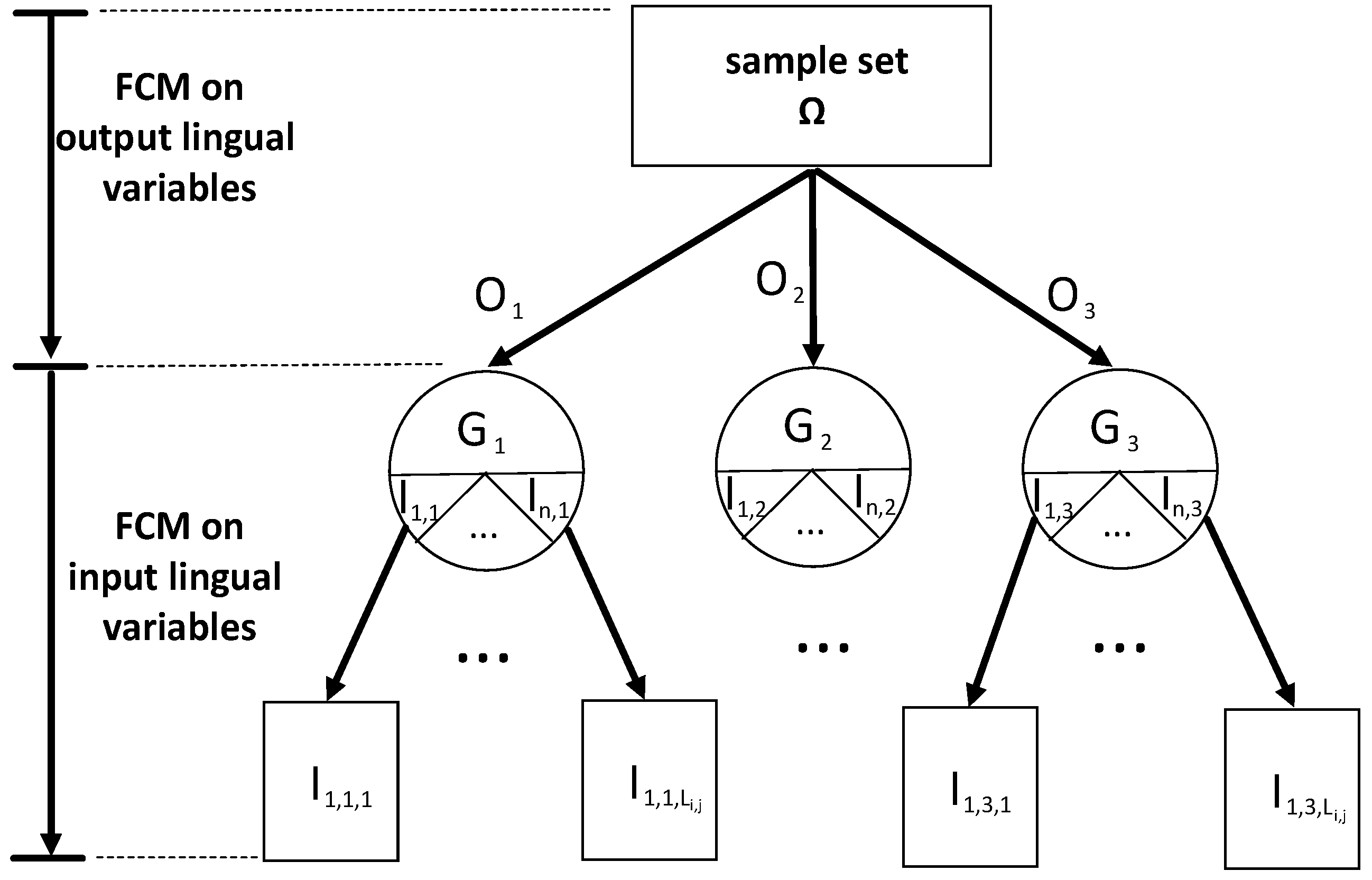
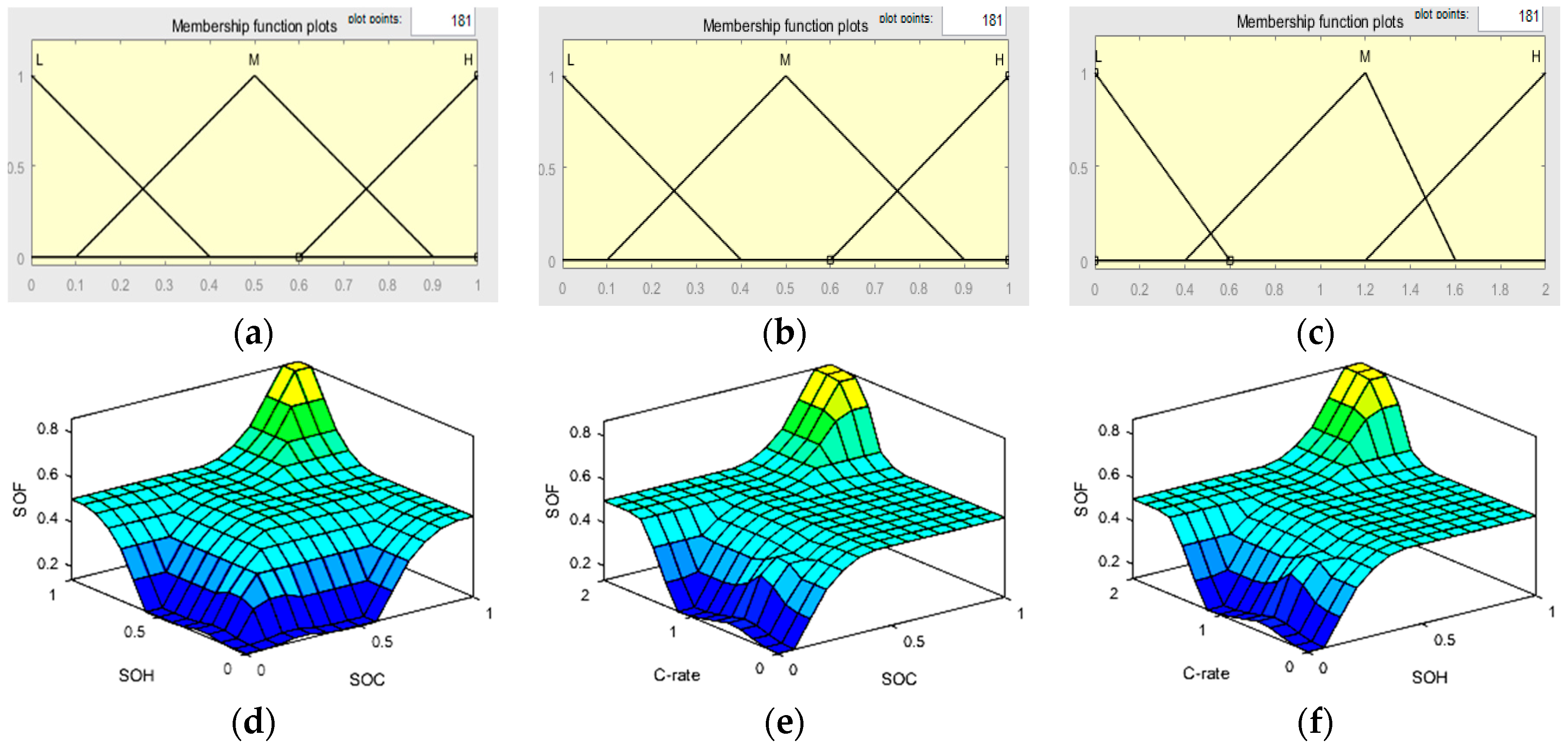
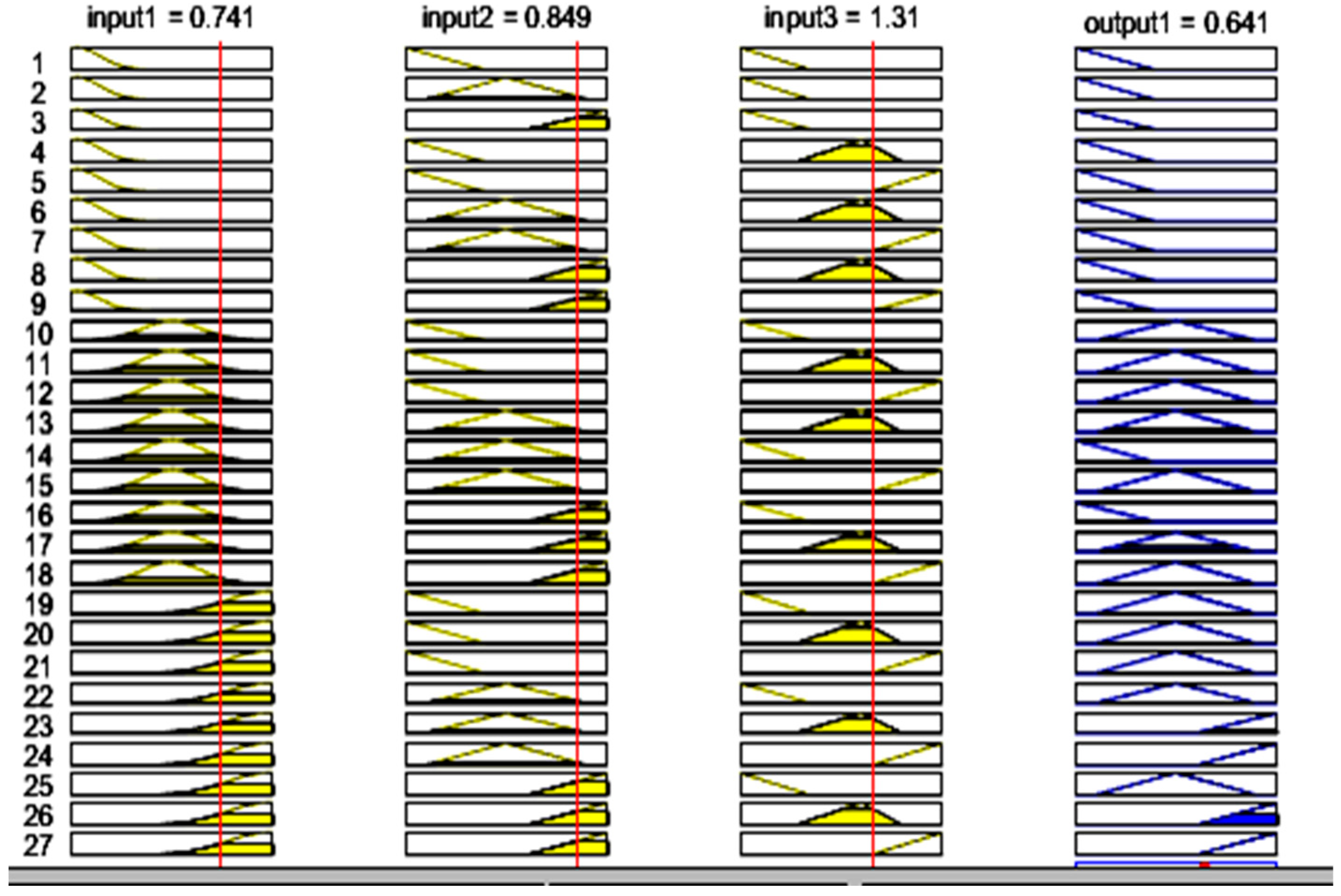
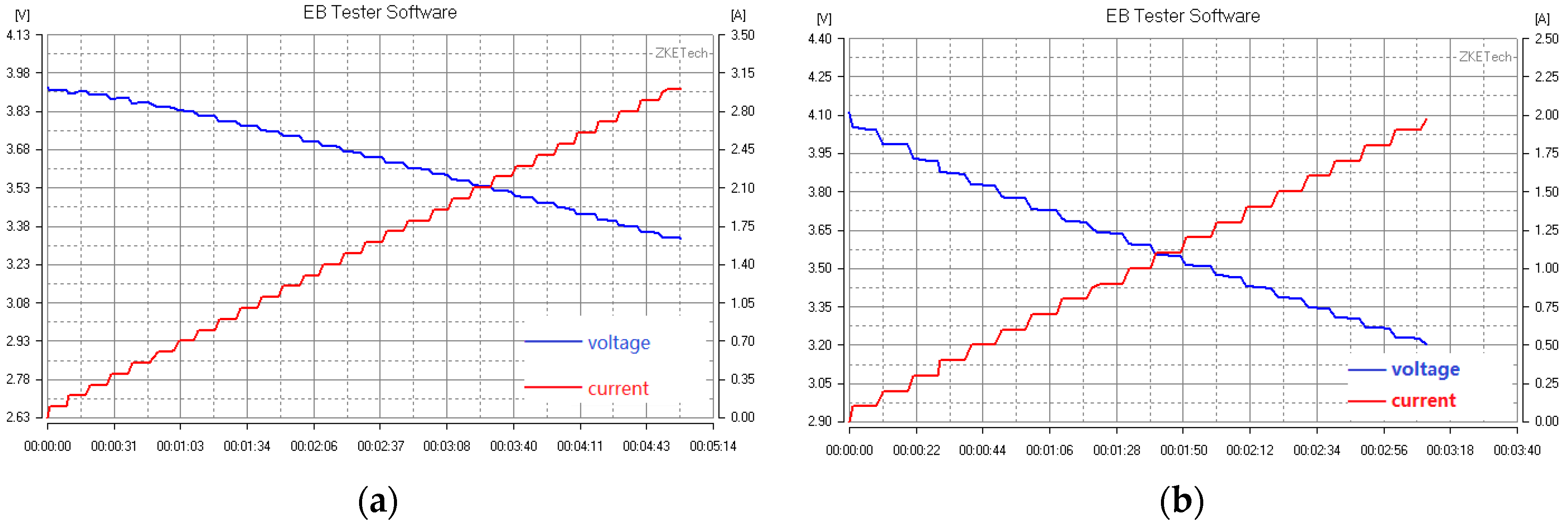


| Index | Voltage | Current | SOH | SOF-ESTIMATED | Index | Voltage | Current | SOH | SOF-ESTIMATED |
|---|---|---|---|---|---|---|---|---|---|
| 1 | 3.90 | 0.1 | 0.849 | 0.817 | 12 | 3.67 | 1.2 | 0.849 | 0.799 |
| 2 | 3.85 | 0.2 | 0.849 | 0.795 | 13 | 3.67 | 1.3 | 0.849 | 0.84 |
| 3 | 3.84 | 0.3 | 0.849 | 0.802 | 14 | 3.66 | 1.4 | 0.849 | 0.825 |
| 4 | 3.80 | 0.4 | 0.849 | 0.832 | 15 | 3.65 | 1.5 | 0.849 | 0.788 |
| 5 | 3.78 | 0.5 | 0.849 | 0.840 | 16 | 3.64 | 1.6 | 0.849 | 0.803 |
| 6 | 3.77 | 0.6 | 0.849 | 0.787 | 17 | 3.62 | 1.7 | 0.849 | 0.866 |
| 7 | 3.74 | 0.7 | 0.849 | 0.817 | 18 | 3.61 | 1.8 | 0.849 | 0.825 |
| 8 | 3.74 | 0.8 | 0.849 | 0.794 | 19 | 3.60 | 1.9 | 0.849 | 0.773 |
| 9 | 3.72 | 0.9 | 0.849 | 0.793 | 20 | 3.60 | 2.0 | 0.849 | 0.810 |
| 10 | 3.69 | 1.0 | 0.849 | 0.811 | 21 | 3.59 | 2.1 | 0.849 | 0.803 |
| 11 | 3.68 | 1.1 | 0.849 | 0.829 | 22 | 3.62 | 2.2 | 0.849 | 0.800 |
© 2019 by the authors. Licensee MDPI, Basel, Switzerland. This article is an open access article distributed under the terms and conditions of the Creative Commons Attribution (CC BY) license (http://creativecommons.org/licenses/by/4.0/).
Share and Cite
Wang, D.; Yang, F.; Gan, L.; Li, Y. Fuzzy Prediction of Power Lithium Ion Battery State of Function Based on the Fuzzy c-Means Clustering Algorithm. World Electr. Veh. J. 2019, 10, 1. https://doi.org/10.3390/wevj10010001
Wang D, Yang F, Gan L, Li Y. Fuzzy Prediction of Power Lithium Ion Battery State of Function Based on the Fuzzy c-Means Clustering Algorithm. World Electric Vehicle Journal. 2019; 10(1):1. https://doi.org/10.3390/wevj10010001
Chicago/Turabian StyleWang, Dasong, Feng Yang, Lin Gan, and Yuliang Li. 2019. "Fuzzy Prediction of Power Lithium Ion Battery State of Function Based on the Fuzzy c-Means Clustering Algorithm" World Electric Vehicle Journal 10, no. 1: 1. https://doi.org/10.3390/wevj10010001
APA StyleWang, D., Yang, F., Gan, L., & Li, Y. (2019). Fuzzy Prediction of Power Lithium Ion Battery State of Function Based on the Fuzzy c-Means Clustering Algorithm. World Electric Vehicle Journal, 10(1), 1. https://doi.org/10.3390/wevj10010001





